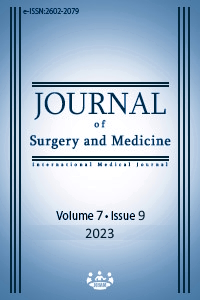The prevalence and impact of sarcopenia in myeloproliferative neoplasms
Sarcopenia in in myeloproliferative neoplasms
Keywords:
sarcopenia, prevalence, myeloproliferative neoplasm, muscle strength, muscle massAbstract
Background/Aim: Rapid identification of patients with myeloproliferative neoplasms (MPNs) is crucial for clinical decision-making and healthcare management. Sarcopenia is characterized by muscle loss and increases the risks for adverse outcomes; there is limited information in the literature regarding possible links between sarcopenia and MPNs. This study evaluated the frequency of sarcopenia in patients with MPNs and investigated whether biochemical or clinical features were associated with the development of sarcopenia.
Methods: Fifty-six BCR-ABL1-negative patients were included in this randomized prospective cohort research study. Muscle strength was measured using a handgrip dynamometer. Muscle mass was evaluated using a bioelectrical-impedance analyzer, and physical performance was evaluated via gait speed in a 6-minute walking test.
Results: The mean handgrip strength of the cohort was 27.7 kg, and 13 patients (23.2%) tested positive for low muscle strength. Mean muscle mass was found to be 7.58 (1.17) kg/m2, and seven patients (12.5%) exhibited low muscle mass. Three patients (5.4%) had low muscle quality. Nine patients (16.1%) were diagnosed with probable sarcopenia, and four patients (7.1%) were diagnosed with severe sarcopenia. There was no difference between the groups in terms of clinical features (P>0.05), nutritional assessment (macro and micronutrients) (P=0.959), comorbidities (P=0.476), or laboratory measurements (P>0.05).
Conclusion: There was a high prevalence of sarcopenia among patients with MPNs, which indicates that periodic measurements of muscle strength, body composition and physical performance may contribute to the management of MPNs.
Downloads
References
Greenfield G, Mcmullin MF, Mills K. Molecular pathogenesis of the myeloproliferative neoplasms. J Hematol Oncol. 2021;14(1):103. DOI: https://doi.org/10.1186/s13045-021-01116-z
Barbui T, Thiele J, Gisslinger H, Kvasnicka HM, Vannucchi AM, Guglielmelli P, et al. The 2016 WHO classification and diagnostic criteria for myeloproliferative neoplasms: document summary and in-depth discussion. Blood Cancer J. 2018;8(2):15. DOI: https://doi.org/10.1038/s41408-018-0054-y
Bankar AR. Association of Frailty with Clinical Outcomes in Myeloproliferative Neoplasms: A Population-based Study from Ontario, Canada, 2022. DOI: https://doi.org/10.1097/01.HS9.0000846900.48214.5b
Cruz-Jentoft AJ, Bahat G, Bauer J, Boirie Y, Bruyère O, Cederholm T, et al. Sarcopenia: revised European consensus on definition and diagnosis. Age Ageing. 2019;48(1):16-31. DOI: https://doi.org/10.1093/ageing/afy169
Gunduz HD, Yildirim T, Ersoy Y. Sarcopenia and clinical presentation. J Turgut Ozal Med Cent 2017;24:121-6.
Biolo G, Cederholm T, Muscaritoli M. Muscle contractile and metabolic dysfunction is a common feature of sarcopenia of aging and chronic diseases: from sarcopenic obesity to cachexia. Clin Nutr. 2014;33(5):737-48. DOI: https://doi.org/10.1016/j.clnu.2014.03.007
Arber DA, Orazi A, Hasserjian R, Thiele J, Borowitz MJ, Le Beau MM, et al. The 2016 revision to the World Health Organization classification of myeloid neoplasms and acute leukemia. Blood. 2016;127(20):2391-405. DOI: https://doi.org/10.1182/blood-2016-03-643544
Kaiser MJ, Bauer JM, Ramsch C, Uter W, Guigoz Y, Cederholm T, et al. Validation of the Mini Nutritional Assessment Short-Form (MNA®-SF): A practical tool for identification of nutritional status. J Nutr Health Aging. 2009;13(9):782-8. DOI: https://doi.org/10.1007/s12603-009-0214-7
Sun M-Y, Chang C-L, Lu C-Y, Wu S-Y, Zhang J-Q. Sarcopenia as an Independent Risk Factor for Specific Cancers: A Propensity Score-Matched Asian Population-Based Cohort Study. Nutrients. 2022;14(9):1910. DOI: https://doi.org/10.3390/nu14091910
Peterson SJ, Mozer M. Differentiating sarcopenia and cachexia among patients with cancer. Nutr Clin Pract. 2017;32(1):30-9. DOI: https://doi.org/10.1177/0884533616680354
Williams GR, Dunne RF, Giri S, Shachar SS, Caan BJ. Sarcopenia in the older adult with cancer. J Clin Oncol. 2021;39(19):2068. DOI: https://doi.org/10.1200/JCO.21.00102
Pin F, Couch ME, Bonetto A. Preservation of muscle mass as a strategy to reduce the toxic effects of cancer chemotherapy on body composition. Curr Opin Support Palliat Care. 2018;12(4):420-6. DOI: https://doi.org/10.1097/SPC.0000000000000382
Xia L, Zhao R, Wan Q, Wu Y, Zhou Y, Wang Y, et al. Sarcopenia and adverse health‐related outcomes: An umbrella review of meta‐analyses of observational studies. Cancer Med. 2020;9(21):7964-78. DOI: https://doi.org/10.1002/cam4.3428
Mehmet E, Saraç ZF, Savaş S, Kilavuz A, Akçiçek SF. Sarcopenia prevalence and the quality of life in older adults: A study from Turkey’s east. Ege Tıp Dergisi. 2021:52-9.
Surov A, Wienke A. Sarcopenia predicts overall survival in patients with malignant hematological diseases: A meta-analysis. Clin Nutr. 2021;40(3):1155-60. DOI: https://doi.org/10.1016/j.clnu.2020.07.023
Burkart M, Schieber M, Basu S, Shah P, Venugopal P, Borgia JA, et al. Evaluation of the impact of cachexia on clinical outcomes in aggressive lymphoma. Br J Haematol. 2019;186(1):45-53. DOI: https://doi.org/10.1111/bjh.15889
Jia S, Qiao R, Xiao Y, Qin D, Zhao W, Zhao Y, et al. Prognostic value of sarcopenia in survivors of hematological malignances undergoing a hematopoietic stem cell transplantation: a systematic review and meta-analysis. Support Care Cancer. 2020;28(8):3533-42. DOI: https://doi.org/10.1007/s00520-020-05359-3
Kamiya T, Mizuno K, Ogura S, Ito C, Fujita Y, Aisa Y, et al. A prospective observational study evaluating sarcopenia by using the bioelectrical impedance analysis in elderly patients with hematologic malignancies. Blood. 2018;132:4851. DOI: https://doi.org/10.1182/blood-2018-99-114545
Kurose S, Nishikawa S, Nagaoka T, Kusaka M, Kawamura J, Nishioka Y, et al. Prevalence and risk factors of sarcopenia in community-dwelling older adults visiting regional medical institutions from the Kadoma Sarcopenia Study. Sci Rep. 2020;10(1):19129. DOI: https://doi.org/10.1038/s41598-020-76185-0
Wu L-C, Kao H-H, Chen H-J, Huang P-F. Preliminary screening for sarcopenia and related risk factors among the elderly. Medicine 100(19):e25946. DOI: https://doi.org/10.1097/MD.0000000000025946
Downloads
- 331 629
Published
Issue
Section
How to Cite
License
Copyright (c) 2023 Yildiz Ipek, MüJgan Kaya Tuna
This work is licensed under a Creative Commons Attribution-NonCommercial-NoDerivatives 4.0 International License.
















